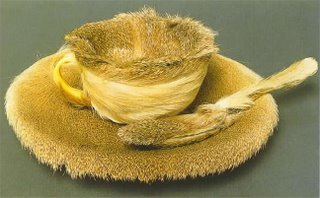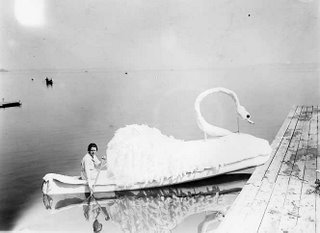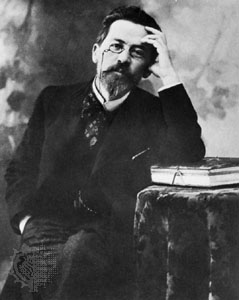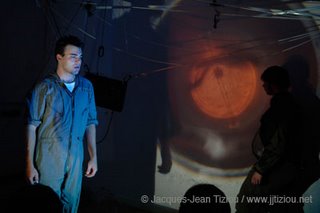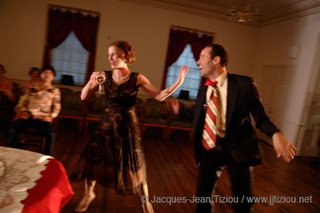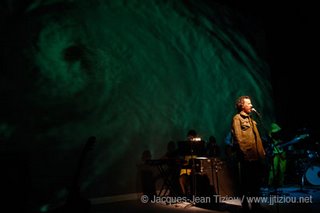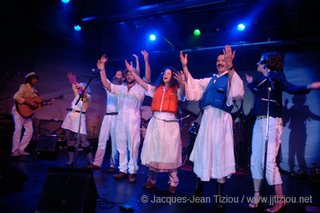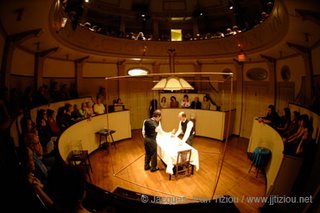A week in Lviv, Ukraine with Pig Iron’s HELL MEETS HENRY HALFWAY
by Dito Van Reigersberg, PITC Co-Artistic Director Sign advertising HELL MEETS HENRY HALFWAY on a street in Lviv
Sign advertising HELL MEETS HENRY HALFWAY on a street in Lviv
THE CAST OF 13 PIG IRON PLAYERS
Dan Rothenberg– the director
Quinn Bauriedel-- the actor playing Walchak
Sarah Sanford -- the actress playing Maya
James Sugg -- the actor playing Ballboy
Mike Crane -- the actor playing Dr. Hincz
Mary McCool -- the actress playing the Prince
Bill Moriarty --the sound designer and operator
Cavan Meese -- the master electrician (in charge of lights)
Andrew Glickman -- the technical director (in charge of set)
Sarah Chandler – the stage manager
Michelle Boone –the production manager
Bill Bauriedel – Quinn’s dad, Russian speaker and super-titles operator
Dito van Reigersberg -- the actor playing Henry and the narrator of this journal
THE KEY UKRAINIAN PLAYERS
Marta, our contact from our hosts Les Kurbas Theatre Company
Stefan, a company member of Les Kurbas and friend of singer Marjana Sadowska (who
Pig Iron trained with in several workshops and who connected us to Les Kurbas in the first place)
Roman the interpreter
Natalya the interpreter
Various Les Kurbas students, including Andre, Taras, 2 Oxanas, etc,
Vlad and Irina in the airport
Day 1
IN WHICH
We have the first installments in the trip’s series of explosive revelations and the Ukrainian plane food makes me feel “uky.”
After a van-ride to JFK from the Pig Iron office with many bright chartreuse Pig Iron suitcases in tow (they are VERY spottable from distances of a mile or more, and there are something like 13 of them, for all of the set and props and whatnots involved in HENRY), we check ourselves in and get ready to fly. Already some cultural differences begin to emerge: one long line forms in front of our gate at JFK with all the passengers on our flight; Aerosvit does not use the boarding-by-section method used by American airlines. But the flight on Aerosvit, with the exception of the nasty airplane food, is comfortable and blissfully unremarkable. I end up doing a lot of crosswords with Sarah Sanford. It’s important to note that a 10 hour flight = 3 movies, so we take in a lot of Hollywood movies of the B- to C-grade variety on the way over. Dazed, we land in Kiev and Mike Crane and I make our first attempts to decode Cyrillic. We turn to a neighbor in the waiting area for pronunciation help, and meet Vladimir and Irina. They generously help us pronounce “Information Booth” in Ukrainian and we strike up a conversation. It turns out Vlad shows us his driver’s license to show us his full name, and the license is from Bensalem, PA, where he lives half the year in the States. What a strange coincidence. Then we tell them we’re in a theatre company and that recently we’ve been working on Chekhov’s Three Sisters (the name Irina makes me mention it) and they are flummoxed as to who I am talking about. The exchange goes something like this:
ME: Chekhov.
VLAD: Who?
ME: Chekhov.
VLAD: Who?
ME: Chekhov.
VLAD: Who?!
ME: Chekhov.
VLAD: Who?! Ah, oh, Ch-HEkhov!
The difference in the way I say it and the way Vlad says it is imperceptible (to me at least), but makes the difference between understanding and total confusion.
In the Kiev airport, we set up camp because you aren’t allowed to check in until an hour before your flight (hence the huge lines that form before any flight takes off). I get some hryvnia, the Ukrainian currency, and set off in search of food; I discover that a sandwich, your basic ham and cheese, costs a dollar here. Finally after a couple of hours’ wait we’re allowed to check in our plethora of Kermit-green bags, and Michelle and Bill Bauriedel wrestle with the airline staff as to whether we paid for our extra baggage’s whole trip to Lviv or just to Kiev. Finally Aerosvit agrees that we paid for the whole trip. Sarah Sanford grabs an Airborne Vitamin-C Supplement from Quinn to keep healthy for the second flight and she gets a physics lesson: when she drops the tablet in her carbonated water, the water bottle explodes. We all look the other way and pretend we don’t know her.
The next leg to Lviv is on an old, vintage plane called an Antonov and it is an ancient and creaky flying machine with folding seats, a feature I have never seen before on any aircraft. After an hour or so we finally and gratefully arrive in Lviv and walk to the small terminal to wait for the bags to unload in a garage-like structure. They drive two low trucks full of luggage into the receiving area, and a feeding frenzy for the luggage ensues. It is terrifying.  But then it is a pleasure to finally lay eyes on our hostess Marta, Andre (one of the actors from Les Kurbas), and Roman our interpreter. We drop our bags at our very nice and stately hotel in the city center, The Hotel George, and then we go for dinner to a folklorically-decorated cafeteria/restaurant called Belly Hut, a sort of Busch Gardens meets Olive Garden for Ukrainian youth. Thank God for Imodium. At the restaurant we meet the very kind translators of HENRY into Ukrainian, Vasily and Julie, but I am still stomach-achy and excuse myself to head back to Hotel George to crash.
But then it is a pleasure to finally lay eyes on our hostess Marta, Andre (one of the actors from Les Kurbas), and Roman our interpreter. We drop our bags at our very nice and stately hotel in the city center, The Hotel George, and then we go for dinner to a folklorically-decorated cafeteria/restaurant called Belly Hut, a sort of Busch Gardens meets Olive Garden for Ukrainian youth. Thank God for Imodium. At the restaurant we meet the very kind translators of HENRY into Ukrainian, Vasily and Julie, but I am still stomach-achy and excuse myself to head back to Hotel George to crash.
Day 2
IN WHICH
We meet up with our native theatrical counterparts and are buoyed by their energy.
Breakfast at the hotel is included so I eat heartily, though I must admit that blintzes are not on my personal list of easy-to-digest, traveler-friendly foods. With Quinn and Bill Bauriedel I then take in the main square in Lviv and its four Roman God statues. In this most touristy of spots in Lviv we spot a funny t-shirt, it is printed in the font used in Nokia ads and it reads--Vodka: Connecting People. Bill Bauriedel uses his Russian to get us around, including helping me to appease my sudden lust for bananas, which are sold in street-carts much like in New York City.
We return to the hotel and have our 1st official Pig Iron meeting as a crew of 13 and a line-through with the actors of HELL MEETS HENRY HALFWAY in Sarah Chandler’s room. Then Quinn and I set off to give a physical theatre workshop at the Les Kurbas Theater from 3-5:30 pm; their space is a small but historic blackbox theatre within 5 handy blocks of the hotel. Now, I initially thought “Les Kurbas” meant “The Kurbas,” whoever they might be, I guess like a band name akin to Los Lobos or something, but it turns out this Les is like the name Les, like Les Nessman from WKRP in Cincinnati. And no disrespect is intended by such a bad, pop-culture reference: the man Les Kurbas was a great triumvirate-in-one, a great actor, director and acting teacher.
 Our workshop students number about 16 and include a Taras and 2 Oxana’s; Quinn and I lead warm-ups, some ensemble improvisations called chords and we end with animal-characterization exercises. It is a wonderful albeit short session, and Quinn and I both feel that we have finally “arrived”—lingually we haven’t been able to connect directly with the Ukrainians, but speaking with the students in the language of theatre makes us feel that real understanding has opened up. We are impressed with the students’ energy, facility and commitment; with their grounding in more physically-based acting techniques (much more common in Eastern Europe than in the States) they seem fluent in the theatrical “language” we speak. In terms of actual language, we appreciate how the act of teaching, with the added complication and time-lag of the interpreter, makes us succinct—no words to spare here, we make our points, give our instructions, and word our critiques in some ways more clearly than we would with American actors. We leave on a high, energized by the students’ fearlessness and their willingness to try anything.
Our workshop students number about 16 and include a Taras and 2 Oxana’s; Quinn and I lead warm-ups, some ensemble improvisations called chords and we end with animal-characterization exercises. It is a wonderful albeit short session, and Quinn and I both feel that we have finally “arrived”—lingually we haven’t been able to connect directly with the Ukrainians, but speaking with the students in the language of theatre makes us feel that real understanding has opened up. We are impressed with the students’ energy, facility and commitment; with their grounding in more physically-based acting techniques (much more common in Eastern Europe than in the States) they seem fluent in the theatrical “language” we speak. In terms of actual language, we appreciate how the act of teaching, with the added complication and time-lag of the interpreter, makes us succinct—no words to spare here, we make our points, give our instructions, and word our critiques in some ways more clearly than we would with American actors. We leave on a high, energized by the students’ fearlessness and their willingness to try anything.
We then go to dinner at a restaurant oddly and aptly named 7 Little Piggies, at the generous invitation of Bill Bauriedel. The restaurant is also quite folklorically decorated and has two amazing musicians, on accordion and violin, going from table to table to play beautiful Ukrainian music. The restaurant features an indoor waterwheel and a bridge, a stuffed wild-eyed cat, a huge bear, and a beaver holding up a shot glass, and the cuisine is terrific, nothing like Belly Hut--great borsht, Georgian wine (sweet), Chicken Kiev, and ice cream. At one point in the meal Mary disappears and comes back with a medieval armored belt she’s found, like the kind all the waiters are wearing; she even offers to buy it from the establishment but it’s a little too pricey. On the way back home Roman our interpreter (only 19 but wise beyond his years) points out a monument for the end of communism and talks to me about the current political powers-that-be in Ukraine.
Day 3
IN WHICH
More explosives appear and the word “punchy” comes to Ukraine.
After breakfast I walk around with Mike for a bit, we get as far as the opera house, then turn around and go to the theatre. The theatre we’re performing in is called The First Ukrainian Theater for Children and Youth, it is a block away from the Les Kurbas Theater and is a substantially bigger space so as to fit the show. We begin to unpack and hoist things into place, and discover that 2 huge spiders have come in the wardrobe from Poland. Our brave Michelle takes them both outside. Then from the dressing room I hear more commotion—one of the electrics connecting the lights has sparked, burst into flames, and burns blue for 20 seconds. Michelle warns us to stay away from the stage for the time being. At this point she asks the Ukrainian tech staff for a fire extinguisher because there isn’t one, and no one in the theatre seems capable of producing one. Several stray cats roam about in the theatre. We begin to worry about the rocky technical road ahead.
After lunch Quinn and I go get a rickety wooden ladder from Les Kurbas; it takes a lot of geometry savvy to get it from the second floor down the front door of the theatre and out onto the street. We bring it back to fine-tune the positions of the lights. Not every hand is needed on-deck, however, and so the actors get to draw straws to decide who stays and continues loading in with the technical staff till 10. James and I draw the short straws and march on bravely with Andrew Glickman to lay out the artificial grass for HENRY. We use the group-shuffle method to flatten the turf, meaning we all shuffle our feet together while in a line and travel from end of the turf to the other in order to get the wrinkles out. This repeated group shuffling, as well as the fatigue setting in, gets everyone punchy, and we teach the word “punchy” to Roman. Then we take a deep breath, listen to a Lauryn Hill album as we clean up the day’s messes, and then head to Bar Korzo for nuts and beer.
Day 4
IN WHICH
Ballboy nearly gets singed and all things technical take one step forward and two steps back.
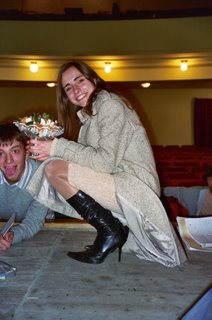 Reading Cyrillic is like code games for childhood. What looks like an H is our N, P is our R, 3 is our Z. It’s fun - if exhausting - work to sound things out, you feel like you are learning to read all over again…but the rewards can be great, because often once you sound out the word it sounds like a cognate of an English word. (We would have been unimaginably lost without our wonderful translators, Roman and Natalya, who are pictured at left.) I learn quickly to sound out the Cyrillic letters for coffee. The other words we learn and rely on most are, phonetically: budLASka = please; and dee-A-kuyu = thank you.
Reading Cyrillic is like code games for childhood. What looks like an H is our N, P is our R, 3 is our Z. It’s fun - if exhausting - work to sound things out, you feel like you are learning to read all over again…but the rewards can be great, because often once you sound out the word it sounds like a cognate of an English word. (We would have been unimaginably lost without our wonderful translators, Roman and Natalya, who are pictured at left.) I learn quickly to sound out the Cyrillic letters for coffee. The other words we learn and rely on most are, phonetically: budLASka = please; and dee-A-kuyu = thank you.
We have breakfast in the hotel again, but the weird Chinese décor on walls and terrible coffee are beginning to drive me crazy. On the upside, I have gotten a reprieve, as has James, for working late the night before, so we get to arrive at the theatre an hour later this morning. Once there I help hold the famous wooden ladder with no safely anythings for Cavan, then we are somewhat ready to start setting cues. We aren’t that far into the play when James as Ballboy is sitting on top of the wardrobe and a light explodes. A piece of molten glass falls two inches to his right. We all panic and yell at him to get down from the wardrobe, and when he returns to the ground we check him for glass splinters. Thankfully he is splinter-free. Svetlana is in charge of lights, very nice nerdy lady with enormous glasses and a braid down her back, and she is seemingly the only woman working here in the tech world. She informs us that, unfortunately, these particular lights are going to be unreliable if turned up past 50% capacity.
We are despondent, feeling like we have come on tour with a play that has far too many technical demands and that something disastrous is bound to happen. To nurse James’ wounds we go to a higher-end place for dinner, Prague Restaurant; at least there we get some really good food. It is an elegant and fastidious fine dining place with a suave waiter (Sarah and I watch our P’s and Q’s, of course) but the food is appearing way too slowly and we’re panicking. We’re expected at the theater. Sarah goes back to the theatre to explain that we’ve past the point of no return, our food is almost ready but still being prepared. Our patience is rewarded with a delicious pork roast, lasagna, potato croquettes, and bread with exquisitely flavored butters. Full and recharged we go back to the theatre and write more cues. We are informed, and are relieved to hear, that a new slew of lights has been delivered to the theatre, to replace the “exploders,” and will be re-hung the next morning by Cavan and our fearless crew. I head to bed early to be ready for our day of Ukrainian fame (or perhaps infamy) tomorrow.
Day 5
IN WHICH
Sarah Sanford and I make a TV appearance, a black cloud descends upon the theatre, the Ukrainian word “Katastroph!” is introduced to Pig Iron, and then the tide decidedly turns.
This is the big day, I think to myself. I’ve had a fitful night’s sleep knowing I have to wake up at 7:15 to be ready for a TV interview at 8. I thought I would save time by shaving the night before, but it turns out I have missed huge patches on my chin. Roman comes and picks up Sarah and me and we take a taxi to the TV station on a hill with the “Eiffel Tower” (really the TV tower). We wait to be admitted. We practice questions on each other (especially the ubiquitous “Why is your company named Pig Iron?” (My answer, after much practice, becomes as pithy and elegant as any I could muster, and coming from a family of interpreters (as I do), I imagine that it’s easier to translate a pithy, elegant explanation rather than a long, rambling one: “There are three reasons—1) we were attracted to the idea of the crude stage weight, called pig iron, that is used in a pulley system to fly the scenery, it is something heavy and raw that creates an image of flight; 2) we come from Pennsylvania, a state that produces many metal products including pig iron; and 3) the words “pig” and “iron” are two funny words that don’t usually go together in English and as an interdisciplinary company we try to make unusual and unexpected combinations in our work”).
A heavily made-up woman admits us to the TV studio building and we are led through endless Kafkaesque hallways (with a heavy stench, from mops I suspect—there seems to be a great desire to mop in Ukraine, our students did so too before our workshop but with old and rank cleaning implements) to a small brightly lit room with two hostesses (I immediately dub them Good Cop/Bad Cop or Good Witch/Bad Witch). Bad Cop is a redhead and Amazonian in height, the other is short and perky and blonde. BC looks at the press release for HENRY and says, “Sex and tennis?! Tell me MORE!” while the blonde GC asks us more primly about the name Pig Iron (I’m ready for it!), the play, why people should come and see it, and what we would say to the city of Lviv.  We answer that we’d like to thank Lviv for its tremendous hospitality. We try to express that the play is a dark comedy and that its rapid-fire tennis-like dialogue and exaggerated, gothic characters make it exciting even if every single word isn’t understood. We mention that we have Ukrainian supertitles. When we say that in Pig Iron we make original work, they ask us if we prefer adapting classics or modern works. Sarah, by answering that works from the canon are easier to adapt than modern works, throws poor Roman for a loop. After we cut to commercial he asks: What cannon are you talking about? Much confusion ensues until I remember that the word canon sounds just like cannon. Oh well. Now Roman knows canon AND punchy. Lucky him. We are dismissed from the TV station, once we pose for a picture with our two hostesses.
We answer that we’d like to thank Lviv for its tremendous hospitality. We try to express that the play is a dark comedy and that its rapid-fire tennis-like dialogue and exaggerated, gothic characters make it exciting even if every single word isn’t understood. We mention that we have Ukrainian supertitles. When we say that in Pig Iron we make original work, they ask us if we prefer adapting classics or modern works. Sarah, by answering that works from the canon are easier to adapt than modern works, throws poor Roman for a loop. After we cut to commercial he asks: What cannon are you talking about? Much confusion ensues until I remember that the word canon sounds just like cannon. Oh well. Now Roman knows canon AND punchy. Lucky him. We are dismissed from the TV station, once we pose for a picture with our two hostesses.
 Then Roman takes us up the hill to a lookout point with a 360-degree vista of Lviv, and we, though sleep-deprived, realize we will be the envy of all the Pig Ironers drowsing away in the city below. We see many majestic churches and buildings on one side, huge tracts of blocky communist housing (built on the cheap with walls that are too thin, according to Roman) on the other. And crows and long-eared squirrels provide local color on the trail up the hill. Then we trek back down to the city center, past the place where Roman had his high school graduation dinner, past a Soviet-era 25-foot statue of a man holding a book and celebrating the printing press and past some odd pink-and-gray painted benches. Then we arrive at Roman’s church, a type of Catholic Church but not the Roman Catholic variety. It is the church he sang in as a member of the choir in his younger days. He asks Sarah if she believes in God, and she says yes but that she was raised Protestant. Roman then asks me if I want to participate in the local custom (I was raised Catholic, so I remember some things…). Following his lead, I kiss an icon of Mary and Jesus, one kiss for each, then I wipe my kisses with the provided hanky. We leave and head closer to the center of town, stopping in at the Lviv pharmacy museum, where Sarah buys a potion for fortifying the hemoglobin and iron that she has read about in her guidebook. Then Roman pays for us (the man has real civic pride!) to see the pretty inner courtyard of the History Museum, an Italianate café with a photography exhibit.
Then Roman takes us up the hill to a lookout point with a 360-degree vista of Lviv, and we, though sleep-deprived, realize we will be the envy of all the Pig Ironers drowsing away in the city below. We see many majestic churches and buildings on one side, huge tracts of blocky communist housing (built on the cheap with walls that are too thin, according to Roman) on the other. And crows and long-eared squirrels provide local color on the trail up the hill. Then we trek back down to the city center, past the place where Roman had his high school graduation dinner, past a Soviet-era 25-foot statue of a man holding a book and celebrating the printing press and past some odd pink-and-gray painted benches. Then we arrive at Roman’s church, a type of Catholic Church but not the Roman Catholic variety. It is the church he sang in as a member of the choir in his younger days. He asks Sarah if she believes in God, and she says yes but that she was raised Protestant. Roman then asks me if I want to participate in the local custom (I was raised Catholic, so I remember some things…). Following his lead, I kiss an icon of Mary and Jesus, one kiss for each, then I wipe my kisses with the provided hanky. We leave and head closer to the center of town, stopping in at the Lviv pharmacy museum, where Sarah buys a potion for fortifying the hemoglobin and iron that she has read about in her guidebook. Then Roman pays for us (the man has real civic pride!) to see the pretty inner courtyard of the History Museum, an Italianate café with a photography exhibit.
By then, quite hungry for breakfast and good coffee, we ask Roman to lead us to the best place to eat in Lviv. “Or—umm—what about your house?” He laughs and says sure, as long as his dad is dressed and warned of our invasion ahead of time. Roman checks upstairs while we wait below, we get the thumbs-up, and then—presto—we gain admittance to a real live Ukrainian apartment. It is quite cozy and small, definitely humble on the inside even if located on the main square and grandiose on the outside (thanks to UNESCO and the main square having been declared a world heritage site, his house will eventually be totally restored inside and out). Then as Sarah and I sit in the kitchen several wonders of the gastronomic variety begin to appear—amazing pot roast, pumpkin Arborio rice, terrific coffee. We meet Roman’s nice violinist dad, who is quite diminutive compared to his giant 6’3” offspring. We see lots of pictures of Roman’s trip to the US, his job as a waiter at a racetrack on Lake George, his foray to the Grand Canyon, and his model-gorgeous Ukrainian girlfriend (or his “sometimes girlfriend” as he grumblingly dubs her).
Then it is time to go back to the hotel to prep for dress rehearsal/opening night. I quickly try to fix my shaving errors. At the theatre we warm up for our dress rehearsal in a cold marble-floored lobby, brrr, then begin a dress rehearsal. We are told that the sound operated by Bill Moriarty will be as we’re used to but that Cavan and Sarah Chandler will be improvising the light cues as we go, as best they can. Cavan is running the lights for HENRY on two manual boards, one from 1957 (he does a hilarious personification of this board as a feeble old man) and even the newly replaced lights are flickering and, as we learned from the Ballboy experience, are potentially dangerous if brought up to an intensity level they can’t handle. I get the feeling that Cavan is doing some crazy math in his head every time he changes to the next light cue.
Additionally, the biggest set element, the wooden wardrobe, is the version made in Eastern Europe for our last tour and is made of thicker and heavier wood than our usual wardrobe. The wardrobe’s graceful spins and up-turnings and re-rightings that we got used to in the States become, in this rehearsal, a series of belabored, embarrassing grunting sessions and shameful demonstrations of the ineffectualness of man versus nature. Muttering men from the staff of the First Ukrainian Theatre of Children and Youth also traipse willy-nilly through our rehearsal to their offices above the stage, very distracting and adding to the black cloud of low morale hanging over us. Dan and I independently think: “This is going to be a disaster” and when we began hearing the cognate “Katastroph!” out of the mouths of the Ukrainians present, we despair.
 And yet the play begins to enter the room. Our focus might be spotty, we may begin to forget lines we never have forgotten before, but then somehow—despite erratic flashing lights, some missing props (including my Henry suspenders) and too many distractions to name, HENRY begins to find its feet. With ambivalence and still-wacky digestive system, I march over with Sarah, Mary, James, and Mike to Belly Hut for an unimpressive preshow dinner. In a last-ditch search for replacements for Henry’s suspenders in Lviv, I locate a pair but they cost 250 hryvnia, or 50 bucks. And some deity seems to want to block the purchase that I almost make, because the menswear store doesn’t take credit cards. Finally James makes me a makeshift set of suspenders out of tie-line 5 minutes before the show, and my confidence (and proper waistline level) returns.
And yet the play begins to enter the room. Our focus might be spotty, we may begin to forget lines we never have forgotten before, but then somehow—despite erratic flashing lights, some missing props (including my Henry suspenders) and too many distractions to name, HENRY begins to find its feet. With ambivalence and still-wacky digestive system, I march over with Sarah, Mary, James, and Mike to Belly Hut for an unimpressive preshow dinner. In a last-ditch search for replacements for Henry’s suspenders in Lviv, I locate a pair but they cost 250 hryvnia, or 50 bucks. And some deity seems to want to block the purchase that I almost make, because the menswear store doesn’t take credit cards. Finally James makes me a makeshift set of suspenders out of tie-line 5 minutes before the show, and my confidence (and proper waistline level) returns.
And the show!
Our translators must have done a terrific job, because the audience’s reception of the show feels so alive, so exciting, so full of laughter and gasps, even some shock at the intensity of the language. The show goes off with a modicum of lighting surreality but mainly without a hitch. We are called out for a standing ovation, we get four bows and are presented flowers. Exhilarated, we go back to the dressing rooms and get changed. A blond woman comes back and is full of compliments, calling Walchak “So typical! Typical American! Like my ex-husband!” We all giggle. And she and her friend both give us her sincere thanks for the performance.
We make our way to Les Kurbas Theatre for a party with the students, which turns out to be, in many ways, the highlight of our trip. A sing-off begins between the students of Les Kurbas and Pig Iron. Stefan (Marjana Sadowska’s friend and a company member of Les Kurbas) leads all their strong voices in harmony. We answer back with our own songs as best we can, taking turns. We sing songs we learned from our Swedish friends Slava, from the Beatles, from Queen and Mission to Mercury. They sing plenty of folk songs (Lviv is known for its folk music) including love songs about berrypicking in the woods and horse carts that fall apart. We blend a song we know with a song they know and they lock together stunningly. It’s a stereotypical picture of a cultural exchange, and an absolutely lovely one. We form a circle and dance as we harmonize, eat cheese, drink wine. It’s such a joyful time, and even the beleaguered technicians agree that all the hell we’ve been through is worth it for this moment of feeling of being here, with people, of celebrating together and going beyond mere tourism or a formal visit. We feel the human connection that was started in the workshop open up and flower. There’s lots of toasting with a boisterous “BUDMO!” and we propose a toast both to them and to Marjana in absentia. We all run out of songs and the adrenaline is fading, to be replaced with true fatigue. Back in the hotel we continue the party, drinking vodka and apple juice in Sarah Chandler’s stately room. Antics of all descriptions ensue. It is a late night but full of joy and relief. Even my stomach feels cured.
Day 6
IN WHICH
Les Kurbas and Pig Iron see each other by the light of day but the love does not fade, HENRY’s run in Lviv ends and Cavan’s theory of sleep deprivation is put to the test.
We are set to have an official talk with Les Kurbas students at 11 AM but all of them are tired and trickling in—many had partied after we left, yesterday was the Day of the Student and a big night for carousing and clubbing in Lviv. Quinn, Dan and I talk through our interpreter Roman for an hour or so about arts funding in the US, theatre training, finding one’s audience, why the name Pig Iron, etc. Then we go to take our last looks at Lviv, stopping in at the oldest bar in the city, called The Blue Bottle (from 1501!). We go for lunch in a decent burrito place and do some souvenir shopping at an open-air market. I stop in at a great coffeehouse, The World of Coffee, with Mike, then it’s time to prep for Show 2.
Back at the hotel, I break my key in the room door on my way out and the no-nonsense, severely-coiffed-with-white-stripe-like-a-skunk lady at the desk gets mad at me. I apologize and run to the theatre. Show 2 is quieter and we hear less giggles from the audience; there are more press and older people in the audience maybe but still the crowd is responsive and this HENRY performance feels like a more tragic show, more emotional. I do break a glass during the dinner scene, but other than that the dangers of HENRY’s load-in don’t seem to follow us into the shows. We get a very warm curtain call followed by a Q-and-A, with Natalya interpreting for us in her tall boots. We are asked questions about Ballboy’s excellent Ukrainian (James always tries to learn a chunk of his Ballboy text in the native language when we’re on tour, even when we have supertitles, and the love he receives from the audience in return is palpable!), about American actors’ work ethic, and about what happens to the Prince and Hinch after the play ends (“I think the Prince turns into a beautiful woman,” coyly offers our student Andre to Mary).
Then it’s time to strike the set and lights, many hands make short work of it. We give Pig Iron t-shirts and CD’s of LUCIA to our Ukrainian friends as tokens of our gratitude. Then it’s off to Bar Korzo again for beers and nuts, and from there we dare to go to a Ukrainian nightclub called Picasso. Even Dan dances up a storm and since we’re leaving at 5:45 in the morning for the airport we decide to stay up till departure time, as much as we can. We are all inspired by Cavan’s theory of sleep deprivation—he advocates no sleeping at all the night before flying back to the States. He touts it as a way to get back into American time and to beat jet lag (I must say this theory depends on all flight connections going smoothly to make sleeping pretty soon on the plane a possibility).
We say our final thanks and goodbyes to Roman and Marta, the sun isn’t yet up when we gather in the hotel lobby and the van that brought us here comes to take us away. We are the first ones at Lviv Airport, and we suffer the grind of dragging around our 22 bags, then we’re off on the Antonov to Kiev. We discover that our plane to the US is delayed for 4-6 hours, and we are crestfallen. Any connections—Sarah Chandler’s to North Carolina, Mike Crane’s to California—will be missed. This isn’t funny anymore. Argh. We take brutal naps in odd positions. We wait. We sleep. We read. We finally get onto the plane, and we get home way too late, no matter what time zone your body thinks you’re in.
Once home we all begin to reminisce and wax sentimental, sending gushy emails back and forth to one another, emails of gratitude and astonishment that we pulled off the seemingly impossible. We have suffered, we have overcome, and we’re so glad we did. Dan, in one email, calls it “at once the most triumphant and the most amateurish thing I’ve been involved in in a long long time.” I couldn’t have put it better myself.
CURTAIN
 Sign advertising HELL MEETS HENRY HALFWAY on a street in Lviv
Sign advertising HELL MEETS HENRY HALFWAY on a street in Lviv But then it is a pleasure to finally lay eyes on our hostess Marta, Andre (one of the actors from Les Kurbas), and Roman our interpreter. We drop our bags at our very nice and stately hotel in the city center, The Hotel George, and then we go for dinner to a folklorically-decorated cafeteria/restaurant called Belly Hut, a sort of
But then it is a pleasure to finally lay eyes on our hostess Marta, Andre (one of the actors from Les Kurbas), and Roman our interpreter. We drop our bags at our very nice and stately hotel in the city center, The Hotel George, and then we go for dinner to a folklorically-decorated cafeteria/restaurant called Belly Hut, a sort of  Our workshop students number about 16 and include a Taras and 2 Oxana’s; Quinn and I lead warm-ups, some ensemble improvisations called chords and we end with animal-characterization exercises. It is a wonderful albeit short session, and Quinn and I both feel that we have finally “arrived”—lingually we haven’t been able to connect directly with the Ukrainians, but speaking with the students in the language of theatre makes us feel that real understanding has opened up. We are impressed with the students’ energy, facility and commitment; with their grounding in more physically-based acting techniques (much more common in
Our workshop students number about 16 and include a Taras and 2 Oxana’s; Quinn and I lead warm-ups, some ensemble improvisations called chords and we end with animal-characterization exercises. It is a wonderful albeit short session, and Quinn and I both feel that we have finally “arrived”—lingually we haven’t been able to connect directly with the Ukrainians, but speaking with the students in the language of theatre makes us feel that real understanding has opened up. We are impressed with the students’ energy, facility and commitment; with their grounding in more physically-based acting techniques (much more common in  Reading Cyrillic is like code games for childhood. What looks like an H is our N, P is our R, 3 is our Z. It’s fun - if exhausting - work to sound things out, you feel like you are learning to read all over again…but the rewards can be great, because often once you sound out the word it sounds like a cognate of an English word. (We would have been unimaginably lost without our wonderful translators, Roman and Natalya, who are pictured at left.) I learn quickly to sound out the Cyrillic letters for coffee. The other words we learn and rely on most are, phonetically: budLASka = please; and dee-A-kuyu = thank you.
Reading Cyrillic is like code games for childhood. What looks like an H is our N, P is our R, 3 is our Z. It’s fun - if exhausting - work to sound things out, you feel like you are learning to read all over again…but the rewards can be great, because often once you sound out the word it sounds like a cognate of an English word. (We would have been unimaginably lost without our wonderful translators, Roman and Natalya, who are pictured at left.) I learn quickly to sound out the Cyrillic letters for coffee. The other words we learn and rely on most are, phonetically: budLASka = please; and dee-A-kuyu = thank you. We answer that we’d like to thank Lviv for its tremendous hospitality. We try to express that the play is a dark comedy and that its rapid-fire tennis-like dialogue and exaggerated, gothic characters make it exciting even if every single word isn’t understood. We mention that we have Ukrainian supertitles. When we say that in Pig Iron we make original work, they ask us if we prefer adapting classics or modern works. Sarah, by answering that works from the canon are easier to adapt than modern works, throws poor Roman for a loop. After we cut to commercial he asks: What cannon are you talking about? Much confusion ensues until I remember that the word canon sounds just like cannon. Oh well. Now Roman knows canon AND punchy. Lucky him. We are dismissed from the TV station, once we pose for a picture with our two hostesses.
We answer that we’d like to thank Lviv for its tremendous hospitality. We try to express that the play is a dark comedy and that its rapid-fire tennis-like dialogue and exaggerated, gothic characters make it exciting even if every single word isn’t understood. We mention that we have Ukrainian supertitles. When we say that in Pig Iron we make original work, they ask us if we prefer adapting classics or modern works. Sarah, by answering that works from the canon are easier to adapt than modern works, throws poor Roman for a loop. After we cut to commercial he asks: What cannon are you talking about? Much confusion ensues until I remember that the word canon sounds just like cannon. Oh well. Now Roman knows canon AND punchy. Lucky him. We are dismissed from the TV station, once we pose for a picture with our two hostesses. Then Roman takes us up the hill to a lookout point with a 360-degree vista of Lviv, and we, though sleep-deprived, realize we will be the envy of all the Pig Ironers drowsing away in the city below. We see many majestic churches and buildings on one side, huge tracts of blocky communist housing (built on the cheap with walls that are too thin, according to Roman) on the other. And crows and long-eared squirrels provide local color on the trail up the hill. Then we trek back down to the city center, past the place where Roman had his high school graduation dinner, past a Soviet-era 25-foot statue of a man holding a book and celebrating the printing press and past some odd pink-and-gray painted benches. Then we arrive at Roman’s church, a type of Catholic Church but not the Roman Catholic variety. It is the church he sang in as a member of the choir in his younger days. He asks Sarah if she believes in God, and she says yes but that she was raised Protestant. Roman then asks me if I want to participate in the local custom (I was raised Catholic, so I remember some things…). Following his lead, I kiss an icon of Mary and Jesus, one kiss for each, then I wipe my kisses with the provided hanky. We leave and head closer to the center of town, stopping in at the Lviv pharmacy museum, where Sarah buys a potion for fortifying the hemoglobin and iron that she has read about in her guidebook. Then Roman pays for us (the man has real civic pride!) to see the pretty inner courtyard of the
Then Roman takes us up the hill to a lookout point with a 360-degree vista of Lviv, and we, though sleep-deprived, realize we will be the envy of all the Pig Ironers drowsing away in the city below. We see many majestic churches and buildings on one side, huge tracts of blocky communist housing (built on the cheap with walls that are too thin, according to Roman) on the other. And crows and long-eared squirrels provide local color on the trail up the hill. Then we trek back down to the city center, past the place where Roman had his high school graduation dinner, past a Soviet-era 25-foot statue of a man holding a book and celebrating the printing press and past some odd pink-and-gray painted benches. Then we arrive at Roman’s church, a type of Catholic Church but not the Roman Catholic variety. It is the church he sang in as a member of the choir in his younger days. He asks Sarah if she believes in God, and she says yes but that she was raised Protestant. Roman then asks me if I want to participate in the local custom (I was raised Catholic, so I remember some things…). Following his lead, I kiss an icon of Mary and Jesus, one kiss for each, then I wipe my kisses with the provided hanky. We leave and head closer to the center of town, stopping in at the Lviv pharmacy museum, where Sarah buys a potion for fortifying the hemoglobin and iron that she has read about in her guidebook. Then Roman pays for us (the man has real civic pride!) to see the pretty inner courtyard of the  And yet the play begins to enter the room. Our focus might be spotty, we may begin to forget lines we never have forgotten before, but then somehow—despite erratic flashing lights, some missing props (including my Henry suspenders) and too many distractions to name, HENRY begins to find its feet. With ambivalence and still-wacky digestive system, I march over with Sarah, Mary, James, and Mike to Belly Hut for an unimpressive preshow dinner. In a last-ditch search for replacements for Henry’s suspenders in Lviv, I locate a pair but they cost 250 hryvnia, or 50 bucks. And some deity seems to want to block the purchase that I almost make, because the menswear store doesn’t take credit cards. Finally James makes me a makeshift set of suspenders out of tie-line 5 minutes before the show, and my confidence (and proper waistline level) returns.
And yet the play begins to enter the room. Our focus might be spotty, we may begin to forget lines we never have forgotten before, but then somehow—despite erratic flashing lights, some missing props (including my Henry suspenders) and too many distractions to name, HENRY begins to find its feet. With ambivalence and still-wacky digestive system, I march over with Sarah, Mary, James, and Mike to Belly Hut for an unimpressive preshow dinner. In a last-ditch search for replacements for Henry’s suspenders in Lviv, I locate a pair but they cost 250 hryvnia, or 50 bucks. And some deity seems to want to block the purchase that I almost make, because the menswear store doesn’t take credit cards. Finally James makes me a makeshift set of suspenders out of tie-line 5 minutes before the show, and my confidence (and proper waistline level) returns.